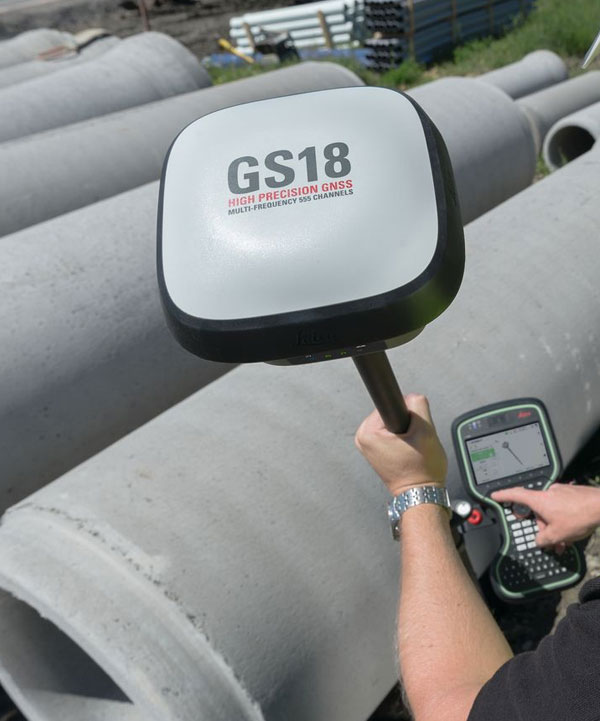| GNSS TECHNOLOGY & SERVICES |
||
| Self-learning GNSS | Leica RTKplus | Adaptive on-the-fly satellite selection |
| HxGN SmartNet Global | HxGN SmartNet Pro HxGN SmartNet+ HxGN SmartNet PPP | Network RTK and unlimited worldwide RTK bridging and PPP service Network RTK and RTK bridging service Unlimited worldwide RTK bridging and PPP service |
| Leica SmartCheck | Continuous check of RTK solution | Reliability 99.99% |
| Signal tracking | GPS | GLONASS Galileo | BeiDou QZSS | NavIC SBAS | TerraStar |
L1, L2, L2C, L5 | L1, L2, L2C, L3 E1, E5a, E5b, AltBOC, E6 | B1I, B1C, B2I, B2a, B3I L1, L2C, L5, L62 | L5 WAAS, EGNOS, MSAS, GAGAN | L-Band, IP |
| RAIM | Receiver Autonomous Integrity Monitoring | Detection and elimination of faulty satellite signals for enhanced position solution and GNSS integrity |
| Number of channels | 555 (more signals, fast acquisition, high sensitivity) | |
| Tilt compensation | Increased measurement productivity and traceability | |
| MEASUREMENT PERFORMANCE & ACCURACY1 |
||
| Time for RTK initialisation | Typically 4 s | |
| Real-time kinematic (Compliant to ISO17123-8 standard) | Single baseline | Hz 8 mm + 1 ppm | V 15 mm + 1 ppm Hz 8 mm + 0.5 ppm | V 15 mm + 0.5 ppm |
| Real-time kinematic tilt compensated | Not for static control points | Additional Hz uncertainty typically less than 5 mm + 0.4 mm/° tilt down to 30° tilt |
| RTK bridging | Up to 10 min bridging of RTK outages | Hz 2.5 cm | V 5 cm |
| PPP | Initial convergence to full accuracy typically 10 min, Re-convergence < 1 min | Hz 2.5 cm | V 5 cm |
| Post processing | Static (phase) with long observations Static and rapid static (phase) | Hz 3 mm + 0.1 ppm | V 3.5 mm + 0.4 ppm Hz 3 mm + 0.5 ppm | V 5 mm + 0.5 ppm |
| Code differential | DGNSS | Hz 25 cm | V 50 cm |
| COMMUNICATIONS |
||
| Communication ports | Lemo | Bluetooth® | WLAN | USB and RS232 serial | Bluetooth® v4.0 (BLE & BR/EDR), class 1.5 | 802.11 b/g/n for field control communication only |
| Communication protocols | RTK data protocols | Leica, Leica 4G, CMR, CMR+, RTCM 2.2, 2.3, 3.0, 3.1, 3.2 MSM NMEA 0183 v4.00 & v4.10 and Leica proprietary VRS, FKP, iMAX, MAC (RTCM SC 104) |
| Built-in LTE modem3 | LTE frequency bands UMTS frequency bands GSM frequency bands | 20, 8, 3, 1, 7 | 13, 17, 5, 4, 2 | 19, 3, 1 8, 3, 1 | 5, 4, 2 | 6, 19, 1 900,1800 | 850,900,1800,1900 MHz |
| Built-in UHF modem4 | Receive & transmit UHF radio modem | 403 – 473 MHz, channel spacing 12.5 kHz, 20 kHz, 25 kHz, max. 1 W output power up to 28800 bps over air; 902 – 928 MHz (licence free in North America), max 1 W output power |
| GENERAL |
||
| Field controller and software | Leica Captivate software | Leica CS20 field controller, Leica CS30 & CS35 tablets |
| User interface | Buttons and LEDs | On / Off and Function button, 8 status LEDs Full status information and configuration options |
| Data recording | Storage Data type and recording rate | Internal memory up to 4 GB, Removable SD card Leica GNSS raw data and RINEX data at up to 20 Hz |
| Power management | Internal power supply External power supply Operating time5 | Internal memory up to 4 GB, Removable SD card Leica GNSS raw data and RINEX data at up to 20 Hz |
| Weight and dimensions | Weight | Dimensions | 1.23 kg / 3.53 kg standard RTK rover setup on pole 173 mm x 173 mm x 109 mm |
| Environmental | Temperature Drop Proof against water, sand and dustVibration Humidity Functional shock |
-40 to +65°C operating, -40 to +85°C storage Withstands topple over from a 2 m survey pole onto hard surfaces IP66 | IP68 (IEC60529 | MIL STD 810G CHG-1 510.6 I | MIL STD 810G CHG-1 506.6 II | MIL STD 810G CHG-1 512.6 I) Withstands strong vibration (ISO9022-36-08 | MIL STD 810G 514.6 Cat.24) 95% (ISO9022-13-06 | ISO9022-12-04 | MIL STD 810G CHG-1 507.6 II) 40 g / 15 to 23 msec (MIL STD 810G 516.6 I) |

